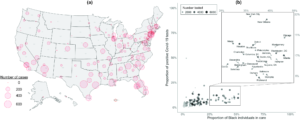30-Day Mortality Rates Were Not Higher Than Whites, However

Fig 1. Distribution of 16,317 laboratory-confirmed COVID-19 cases in the US Department of Veterans Affairs as of July 22, 2020.
(a) Distribution of all COVID-19 laboratory-confirmed cases in the US Department of Veterans Affairs between February 8 and July 22, 2020, included in the current study.
(b) Proportion of positive COVID-19 test results by the proportion of Black individuals in care by site.
WEST HAVEN, CT — Non-Hispanic Black and Hispanic veterans were twice as likely as non-Hispanic white veterans to test positive for COVID-19 at the VA, even after accounting for other demographics, geographic location and underlying health conditions.
The study published in the online journal PLOS Medicine reached those conclusions after reviewing records of about 5.8 million patients in the VA health system. It advised that, although no differences in 30-day mortality were observed among the groups, the disparities underscore the need to tailor COVID-19 prevention strategies to minority communitys.1
VA Connecticut Healthcare System-led researchers focused on statistical associations between VA patients’ race/ethnicity and their detailed medical records, including COVID-19 testing records from Feb. 8 through July 22, 2020. Most of the participants, 91%, were male with 7% of Hispanic ethnicity, 19% Black and 74% white.
With more than 250,000 of the patients receiving a COVID-19 test during the study period, 16,317 tested positive, and 1,057 died within 30 days of testing. Researchers advise that Black and Hispanic veterans were more likely to receive a test and were more likely to test positive than white patients, even when accounting for other demographics underlying medical conditions and geographic location (Black vs. white adjusted Odds Ratio 1.93, 95% CI 1.85-2.01, p<0.001; Hispanic vs. white 1.84, 1.74-1.94, p<0.001).
The study team determined that disparity between white and Black patients was greatest in the Midwest and decreased slightly overall during the study, while the positive-test disparity between Hispanic and white patients was consistent across regions and over time.
The authors said their findings suggest that Black and Hispanic individuals are disproportionately at risk of COVID-19 infection. “Minority individuals who received a positive COVID-19 test did not appear to have worse outcomes,” explained lead author Christopher T. Rentsch, PhD, of the VA Connecticut Healthcare System in West Haven and the London School of Hygiene & Tropical Medicine in the UK. “However, Black and Hispanic individuals were still twice as likely to testing positive for COVID-19, even after accounting for underlying health conditions, other demographics, and geographic location. Taken together, these findings suggest a substantial excess burden of COVID-19 infection in U.S.minority communities.”
Greater Risk
While previous research has suggested that those with certain racial and ethnic minority backgrounds are at greater risk of severe or deadly cases of COVID-19, study authors pointed out that most studies of the disparities only investigated patients who had already tested positive or who were hospitalized.
“No single study to our knowledge has yet investigated racial and ethnic disparities in testing patterns (i.e., who received testing and who tested positive) as well as COVID-19 outcomes in a nationwide cohort with adequate adjustment for potential confounders,” they wrote.
Researchers suggested that understanding disparities in who was tested and whether they tested positive could help with efforts to reduce the burden of COVID-19 in minority communities.
“Understanding what is driving these disparities is vital so that strategies can be tailored to curb the disproportionate epidemics in minority communities … going forward, we are exploring whether racial and ethnic disparities exist at other key stages in the clinical course of COVID-19, from hospitalization to intubation,” Rentsch said. “We appeal to other researchers who have the necessary testing data to investigate disparities in testing and testing positive. This will provide essential information to design effective interventions.”
Testing rates among Black veterans was considerably higher than other groups, according to the study—rate per 1,000 individuals: 60.0, 95% CI 59.6-60.5) compared to Hispanic (52.7, 95% CI 52.1-53.4) and white individuals (38.6, 95% CI 38.4-38.7).
In addition, while members of minority groups were more likely to test positive (Black vs. white: odds ratio [OR] 1.93, 95% CI 1.85–2.01, p < 0.001; Hispanic vs. white: OR 1.84, 95% CI 1.74–1.94, p < 0.001), 30-day mortality did not differ by race/ethnicity (Black vs. white: OR 0.97, 95% CI 0.80–1.17, p = 0.74; Hispanic vs. white: OR 0.99, 95% CI 0.73–1.34, p = 0.94).
Researchers note that study limitations include underrepresentation of women and a lack of detailed information on social determinants of health.
“In this nationwide study, we found that Black and Hispanic individuals are experiencing an excess burden of SARS-CoV-2 infection not entirely explained by underlying medical conditions or where they live or receive care,” they conclude, adding, “There is an urgent need to proactively tailor strategies to contain and prevent further outbreaks in racial and ethnic minority communities.”
The study explained that electronic health records from the VA were used in the study because it is the largest integrated healthcare system in the United States.
